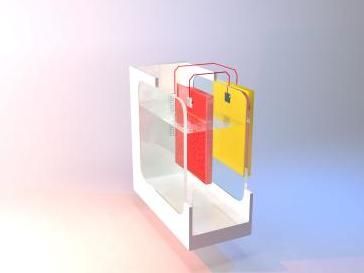Photoelectrochemical water-splitting efficiency hits 4.5%
Photoelectrochemical (PEC) water splitting for hydrogen fuel generation has been considered the Holy Grail of electrochemistry. But to achieve it, many scientists believe the materials have to be abundant and low cost.

Cu2O photocathode-based PEC-PV tandem delivering 4.55% solar-to-hydrogen efficiency.
P. Linfeng/EPFL
The most promising oxide photocathodes are cuprous oxide (Cu2O) photoelectrodes. In 2018 and 2019, researchers at EPFL achieved champion performance with cuprous oxide, rivaling photovoltaic (PV) semiconductor-based photocathodes.
But there was still a piece missing from the puzzle. Even state-of-the-art Cu2O photocathodes still use metallic back contacts (copper or gold), allowing for considerable electron-hole recombination. Other disadvantages include high cost and that the metal contact won't allow unabsorbed sunlight to pass through.
Now, scientists at EPFL show for the first time, that copper thiocyanate (CuSCN) can be used as a transparent and effective hole transport layer (HTL) for Cu2O photocathodes with overall enhanced performance. The research was led by Professors Anders Hagfeldt, Michael Grätzel, and Kevin Sivula at EPFL's Institute of Chemical Sciences and Engineering.
Detailed analysis on two types of CuSCN showed that a defective structure could be beneficial for hole conduction. Moreover, due to the coincidental alignment between valence bands of CuSCN and Cu2O, the band-tail states assisted hole transport in CuSCN was discovered to allow smooth hole conduction while efficiently block electron transport.
The optical advantages of CuSCN were further exhibited through a standalone PEC-PV tandem delivering a solar-to-hydrogen efficiency of 4.55%. This efficiency (4.55% for 12 h) is currently the highest among all Cu2O-based dual-absorber tandems.
The study presents a clear and impressive advancement beyond the state-of-the-art Cu2O photocathodes, which can contribute and inspire future development in the field.
"Though top numbers are achieved with the oxide material in this work, we believe higher values are not far," says Pan Lingfeng, the paper's first author. "At least three aspects are found to be not optimal, but improving them is very feasible. The efficiency value is getting closer and closer to the one that was previously thought to be the threshold for commercialization."
Original publication
Other news from the department science

Get the chemical industry in your inbox
By submitting this form you agree that LUMITOS AG will send you the newsletter(s) selected above by email. Your data will not be passed on to third parties. Your data will be stored and processed in accordance with our data protection regulations. LUMITOS may contact you by email for the purpose of advertising or market and opinion surveys. You can revoke your consent at any time without giving reasons to LUMITOS AG, Ernst-Augustin-Str. 2, 12489 Berlin, Germany or by e-mail at revoke@lumitos.com with effect for the future. In addition, each email contains a link to unsubscribe from the corresponding newsletter.
Most read news
More news from our other portals
Last viewed contents

Klepp Absauganlagen GmbH - Aibling, Germany

CONSORT N.V. - Turnhout, Belgium

JLC-Chemie Handels GmbH - Wiener Neustadt, Austria
Thermo Fisher Scientific Names Winner of 2012 Winter Conference Award in Plasma Spectrochemistry - Submissions now being accepted for 2014 award

SensoQuest GmbH - Göttingen, Germany
Towards sustainable outdoor shooting and fishing - ECHA proposes restrictions on lead use

Peptide Specialty Laboratories GmbH - Heidelberg, Germany

AMONN COATINGS GmbH - Korneuburg, Austria
Gesellschaft für Materialforschung und Prüfungsanstalt für das Bauwesen Leipzig mbH (MFPA Leipzig GmbH) - Leipzig, Germany

AS INGENIEURBÜRO FRICKE - Augsburg, Germany





























































